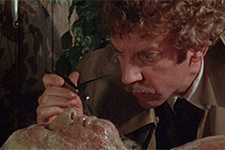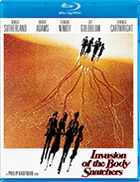Invasion of the Body Snatchers (1978)
|  Over the past two decades, at least since the Michael Bay-produced remake of The Texas Chainsaw Massacre (2003), we have been inundated at the multiplex with remakes of horror classics. This is not necessarily a new development, as the horror genre has always thrived on re-envisioning and reworking archetypal scenarios of fear, whether they revolve around reanimating dead bodies or people turning into animals (it is in this sense that horror stories are fundamentally folkloric in nature). Yet, there is something decidedly modern (and blatantly commercial) about the most recent spate of remakes, primarily because the films make it hard to escape the sneaking suspicion that they are little more than blunt opportunism to cash in on the ability to sell a new generation on a familiar title. These remakes show little, if any, respect for their forebears or desire to elaborate on them beyond pumping them up with empty style, and as a result they play as little more than jacked-up reincarnations of something that was done better several decades earlier. It would seem that Philip Kaufman’s Invasion of the Body Snatchers, a reworking of Don Siegel’s B-movie classic of the same title from 1956, would be a distinct forerunner of this tendency, but it is actually the antithesis of everything that is currently happening and a template for how to do a horror remake right. Rather than simply exploiting a familiar title, Kaufman’s film takes the basic premise from Siegel’s film (both of which draw from Jack Finney’s mid-1950s serialized novel The Body Snatchers) and reimagines it for a different era and a different place, thus making the material entirely new and giving added credence to its deep roots in the fundamental human fear of losing one’s identity. While Siegel’s film played as a paranoid extension of the McCarthy era, suggesting the terrors of small town conformism and the punishment of those who don’t go along with the political status quo, Kaufman’s version (smartly scripted by W.D. Richter, who had previously penned the crime comedy Slither and Peter Bogdanovich’s underappreciated Nickelodeon), satirizes the self-absorbed absurdity of cosmopolitan San Francisco in the Carter years, where self-help gurus, Turkish bath houses, and a general air of personal self-indulgence conspire to make it all the more difficult to differentiate humans from pod people. Kaufman’s film begins on a desolate, dying planet (depicted with fantastically low-budget effects) where gelatinous spores—the seeds that will eventually take over the human race—emerge from a kind of primordial ooze and float into the vacuum of outer space, eventually making their way to Earth, where they attach to various plants, sprout roots, and grow into pretty red flowers that people take home, unaware that they will eventually grow into pods that replicate and then destroy them. The protagonists are two employees of the San Francisco health department: Matthew Bennell (Donald Sutherland) and Elizabeth Driscoll (Brooke Adams). Matthew is a workaholic, intent on uncovering any and all restaurant health violations (at one point in a lab he scrutinizes a baked potato), while Elizabeth is a plant expert who is one of the first to pluck and bring home a space flower. That flower quickly overtakes her boyfriend, a sports-obsessed dentist named Geoffrey (Art Hindle) who can barely take his eyes off the TV and kiss her hello lest he miss a big play. Once he is replicated, however, Geoffrey is all business, a personality change that Elizabeth immediately senses, even if everyone else writes it off, including a famed self-help psychiatrist named Dr. David Kibner (Leonard Nimoy), who sees Elizabeth’s concern as little more than a subconscious ploy for her to escape from a meaningless relationship (Elizabeth’s largely unacknowledged attraction to Matthew, who is himself curiously unattached, is palpable). The other primary characters are Jack Bellicec (Jeff Goldblum), a frustrated would-be poet and good friend of Matthew’s, and his wife Nancy (Veronica Cartwright), who runs a Turkish bath where overweight men submerge themselves in mud and steam in the hopes of cleansing something. Like Matthew and Elizabeth, Jack and Nancy provide the film with fully realized characters who genuinely have something to lose to the space pods; unlike so many cardboard horror victims, they have clever, distinct personalities that we might miss. The setting in late-’70s San Francisco gives room for the characters to have an added dimension of eccentricity—some might say kookiness—that defines them (Nancy at one point states her unquestioned belief that the human race is a result of monkeys breeding with spacemen). To lose that is to lose their humanity. Working with cinematographer Michael Chapman (who shot Scorsese’s Taxi Driver and Raging Bull), Kaufman gives Invasion of the Body Snatchers a great neo-noir feel long before such an approach was trendy and overused. Interiors are shot with blankets of trapezoidal shadows and canted camera angles, and exteriors tend to emphasize a looming sense of danger, even amid the Northern California beauty (in one of the first scenes we briefly glimpse Robert Duvall in an uncredited cameo as a priest on a swing whose menacing blank stare suggests he has become a pod). Without being overbearing, Kaufman makes us feel the tension in the way cosmopolitan anonymity can give way to paranoia and conspiracy (some of the creepy shots of apparent pod people walking the streets were taken surreptitiously without actors). The filmmakers’ respect for the original film is borne out in both the fidelity to and era-appropriate extension of its underlying fears, but also in funny ways, like the casting of director Don Siegel as a taxi driver who may or may not have already been snatched and original star Kevin McCarthy as a version of his 1956 character two decades later, still ranting and raving that “They’re already here!” Much to his chagrin, Siegel was hemmed in by production dictates and forced to frame his paranoid story with a suggestion of hope and victory, which Kaufman is able to jettison, much to the film’s benefit. Kaufman, who would go on to great acclaim in the 1980s for The Right Stuff (1983) and The Unbearable Lightness of Being (1988), is also able to include a lot more humor, which he deploys with malevolent subtlety, but without ever undermining the film’s giddy and overwhelming aura of tension. He also exploits to great effect the then-new developments of Dolby stereo sound (Ben Burtt, who did much of the sound design on Star Wars and later WALL•E, was an important collaborator), which gives the on-screen visuals an added aura of otherworldly grossness. One of the film’s greatest sound effects is “the scream,” a horrifying screech the pod people use to identify residual humans (Abel Ferrara made even better use of it in his criminally underseen 1993 film Body Snatchers). As a result, Invasion of the Body Snatchers is one of the great sci-fi horrorshows, a movie that gooses you with its premise, makes you laugh and jump, and ultimately leaves you with something you can’t quite shake.
Copyright © 2022 James Kendrick Thoughts? E-mail James Kendrick All images copyright © MGM / Kino Lorber | |||||||||||||||||||||||||||||
Overall Rating: 


 (4)
(4)


